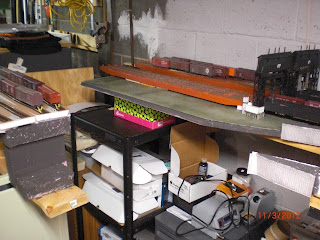Well, here we are, almost the end of 2012, and what a year it's been, a blog "back from the dead" and all that. Big things are in store for the LVHTRy next year, so make sure you keep your browser tuned in here for 2013! And I decided that since all I've been going on about lately are carfloats and floatbridges, I thought I'd wrap up the year and change gears to talk about building a car or two for once! After all, what's a layout without some cars, right?
Shouldn't everyone have one of these cars on their layout? After all, it "contains no horsemeat"!
Welcome to my Little Hobbyshop of Horrors!
Now, if these cars were anything other than simple "shake the box" kits, I know for a fact that they would STILL be sitting up there above the layout. But those Accurail and the older Branchline Yardmaster "kits" that I have amassed build quickly and better yet, nicely, so I was saved the "excuse" of not building anything - time (and money for extra/correct parts) were my only barriers. And with active staging in effect on my layout, these cars can take repeated handling and still retain their ladders and grabs, unlike some of my nicer P2K and Red Caboose cars have already.
As you might not be able to make out in the photo of my "stockpile", in the case of the Yardmaster Series cars, that while I have many different road names to choose from, they are all the same style of boxcar, as opposed to the Accurail cars that I have yet to build that are composed of hopppers, reefers, gondolas, and four different styles of boxcar. Sure, it's nice to get that great feeling of accomplishment when you look at the track full of five dozen (or more!) 40ft. boxcars you just kocked out, but what about the variety, man?! While I've been told that you can never have enough boxcars on your layout, I also know I need to "bulk up" on some of my other car types too, but since I'd rather not buy anything else until I can make some more room, I need to build what I have so I can get around to making room and buy what needs buying!

Never you mind the Phoebe Snow car in the background....
So yes, the roofwalk....As you can see in the photo below.....
Walk the plank, you scurvy dogs!
I hate it when the glue lets go on the roofwalk and you don't notice until AFTER you take the picture!
Now, in the process of building the car, I snapped off one of the stirrups (other side of car), and while I can live with that for now (Lord knows more will snap off down the road), I am considering runing back out tomorrow to the store to pick up a pack of A-Line metal stirrups. Drill, glue and paint, easy-peasy.
The only other part on both cars that seemed "wrong" to me (and is one of those "easy-peasy" fixes), are the brake wheels -
Even with the slight blur, you can tell that the Kadee wheel (left) is that tiny bit nicer and finer in detail than the as supplied Branchline wheel
Branchline's wheel seems a little clunky, and the brakewheel supplied with the Accurail car (not shown) seems to "simple", if you catch my drift. So another message to the group was made to see if Kadee made an appropriate brakewheel, which they do, it's an Ajax item #2030, and that i ran out and purchased on Christmas Eve (gotta love that the Model Railroad Shop - http://www.themodelrailroadshop.com/ - is all of five minutes from my house!).
I also wonder if the replacement for the Accurail car's brakewheel is even worth the trouble replacing, meaning that I know it's going to probably go flying off relatively easily in the act of being "fiddled" in no time at all (and since I first started composing this blog on the 24th, it has!), and I know that Kadee does what appears to be an appropriate metal one, but do I want to even bother with something "nicer" that'll only end up lost (again)? I'm open to suggestions, faithful readers......
I was very lucky that the kind gentleman who helped me with my brakewheel and roofwalk questions also gave me info on the correct doors to use, that being a Creco 7 panel, available from Wright Trak Railroad Models at -
http://www.wrighttrak.com/page3.php?view=productPage&product=56&category=3 -
As well as info on what cars were equipped with Duryea cushioned underframes (not gonna go that far with that detail, thank you!)
I am also told that Speedwitch Media (aka Ted Culotta) also carries it, but he no longer has a website, but IS maintaining a blog - http://speedwitch.blogspot.com/ - And I'll have to remember ask him when I visit his table, if and when I go to the 'Big E' W. Springfield show this January.
Oh, that, and the vertical brake staff needs to be painted on the Accurail car, but that's easy.........
So as I write this, the cars are done (minus the replacement brakewheel for the wood car) and are equipped with Kadee #148 couplers and Intermountain metal wheelsets (in the as-supplied sideframes) and with the addition of extra weight up to 4.6oz (my carfleet standard), these cars run slicker than whale snot a good 10 feet down the Edgewater Branch lead after I let them go at the top of my ruling grade!
So once I tackle the lone brake wheel "issue", I'll sit down and weather these cars up (another favorite activity), but that's another post for next year.
Roll on, and thanks for reading........
Ralph









































